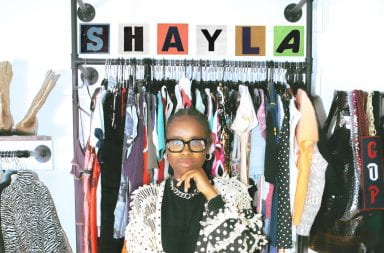
The Willow Theater, a sustainable design created by associate professor of OSU’s Department of Theatre Brad Steinmetz, is located in Cardiff, Wales and served as the point of welcome for guests attending the 2013 World Stage Design Festival.
Credit: Courtesy of Matthew Carbone
Situated in the center of an antiquated courtyard in Cardiff, Wales, a flurry of white fabric strips waved like pennants in the breeze. Making their way through the fluttering fabric, awe-struck visitors carefully wove through a forest of translucent panels artfully suspended from metal scaffolding before entering the interior of this impressive performance space.
From Sept. 5-14, this dynamic structure, The Willow Theater, served as the point of welcome for guests attending the 2013 World Stage Design festival.
The design, created by Brad Steinmetz, an assistant professor of Ohio State’s Department of Theatre, and Tim Lai, architect and co-founder of the ALTernative artist group in Columbus, was chosen by an international panel of judges to be constructed for the festival.
One of more than 100 entries from 26 countries, Steinmetz and Lai’s design endured as the review committee’s favorite, according to Ian Evans, technical director of WSD2013.
“The design brief was a tough one. We asked for a venue that was eco-conscious, could seat up to 150 people, host a variety of events and be self-built, all for an outlay of less than £20,000 (about $32,200)” Evans said in a statement on WSD2013’s website. “The entry from Brad and Tim was everyone’s favorite, though, because as well as meeting the technical brief, it is going to look and feel very interesting — an innovative blueprint that can be copied for other settings.”
The sustainable theater competition was created by WSD2013 in order to offer international artists a chance to design an alternative event venue. The winning theater hosted events specific to the “People, Profit, Planet” program, which encourages increased attention to the issue of environmental sustainability by members of the arts community, as explained on WSD2013’s website.
Steinmetz said he became interested in the sustainable theater competition after completing several theater renovation projects in Ohio.
“I’ve always had an interest in architecture and in theater architecture, specifically,” Steinmetz said. “When I was at the (OSU) Lima campus, they renovated the (Martha W.) Farmer Theater. While I was there, I had the good fortune to work as a member of the construction committee.”
Steinmetz said his increased interest in theater architecture was also influenced by some of his students.
“I had some really fantastic students from the architecture school take courses at the theater department with me. It was a great experience for myself and for my students to get that diversity of experience,” Steinmetz said.
Upon hearing about WSD2013’s theater design competition, Steinmetz was eager to try his hand at theater architectural design.
“I was really excited that this proposal was laid out at the World Stage Design,” Steinmetz said. “I think part of what’s great (about the project), is that it engages theater designers primarily in the work of theater architecture, which is something (where) there is usually a great disconnect.”
Inspired by the work of ALTernative, Steinmetz decided to ask Lai if he would be interested in partnering for the competition.
“I had heard of some of the great things (Lai) had done, including the Bird Mural in the Glen Echo Ravine and also the mural that he did on (Summit and) Hudson Street — the tree mural,” Steinmetz said. “I had this crazy notion that I would just call up (Lai), never having known or met him before, and just ask him politely to work with me … and it worked.”
The newly formed partners began working on the project about five weeks before the deadline, Steinmetz said.
“Each of us came up with a couple of ideas and then we settled on one that we thought would work the best and after that, we really had to work hard,” Steinmetz said.
Steinmetz’s original design was inspired by a horticultural fabric often used in stage productions.
“My first thought when I heard about the call was the opportunity to use a material that I had used in the past for scene design — agricultural fleece. I was excited about maybe using that in a different way — in an architectural way instead of on stage,” said Steinmetz. “What I liked most about it was its sort of lightness and the way it floated and also its translucency.”
Steinmetz and Lai utilized the airiness of the fabric to create the theater’s interactive exterior, which used natural wind power to allow long strips of the agricultural fleece to sway in the breeze.
This movement allowed the structure to become a fluid piece of art, said Eliza Ho, Lai’s wife and co-founder of ALTernative.
“Tim is always interested in creating spaces within spaces and playing around with the idea of ambiguity of spaces. When Brad proposed the use of horticulture materials, it was very (natural) for Tim to come up with the idea of using the fabric to create forms and spaces,” Ho said in an email.
According to Ho, the theater’s name is indicative of the aspects of nature included in the theater design.
“People resonate with nature. Willow trees moving in winds have that poetic quality that we think will connect with the audience,” Ho said.
Steinmetz and Lai were shocked to hear of the selection of their design.
“I was really impressed already by the caliber of work that was coming out for this project,” said Steinmetz, who had the opportunity to view other artists’ submissions prior to the judges’ decision during a presentation at a WSD convention. “So when I found out that we had won, I was actually pretty shocked. But of course, really proud as well and really thankful that I had good people like Tim working on it.”
The theater was constructed by a team of crew members in Cardiff in the weeks prior to WSD2013.
“Tim (Lai) and Brad (Steinmetz) communicated with the construction crew over emails, Skype and phone calls,” Ho said. “Through those (calls and emails), construction drawings were produced, and Tim (Lai) provided answers whenever the crew had questions about the constructions.”
The Willow Theater was completed for the start of WSD2013 on Sept. 5. The theater hosted a variety of performances, exhibitions and workshops throughout the duration of the festival.
Many festival visitors enjoyed interacting with The Willow Theater, Ho said.
“The audience loved to interact with the fabric. It was very rewarding to see how people loved touching and playing with the fabric,” Ho said. “You could see their smiles as they walked through the space, one layer after another. The fact that you can immerse within strips of hanging fabric is just amazing to many people.”
Following the success of their first project as partners, Steinmetz and Lai plan to collaborate on future endeavors.
“I have had a great time working with Tim (Lai) and with Eliza (Ho),” Steinmetz said. “We are already talking about other projects we can work on together. We have sent in a couple of proposals to public art calls around the Midwest.”
Ho said more projects featuring the work of ALTernative and Steinmetz are currently being planned, including the possibility of bringing the Willow Theater to the United States.
“(The theater is) very friendly public art that people of all ages will be able to enjoy,” Ho said. “There are a lot of unexpected surprises that the fabric will create in the environment and that’s truly a beauty that elevates audiences’ senses and consciousness.”
This article has been revised to reflect the following correction:
Correction: Oct. 9, 2013
An earlier version of this story stated that the photo attached to this story was courtesy of ALTernative, in fact the photo is courtesy of Matthew Carbone.


